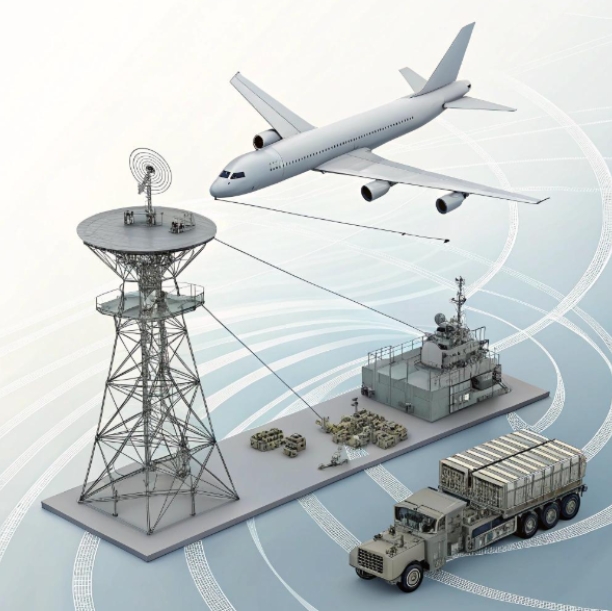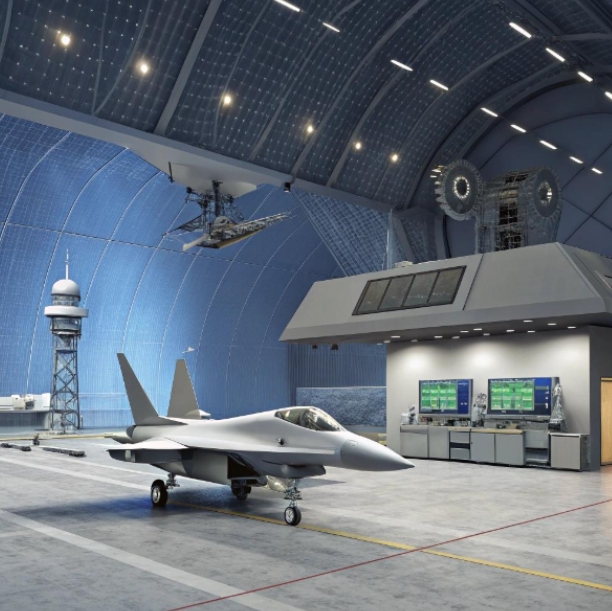The 5G DAS Boom in Aerospace and Defense
As 5G standards continue to evolve and new spectrum (like mmWave and sub-THz) becomes accessible, the potential for 5G DAS in Mil-Aero RF applications is expanding. Future systems will likely incorporate beamforming, AI-defined networking, and autonomous RF management.
The distributed antenna system (DAS) model, once reserved for stadiums and city centers, has now found a new frontier—military and aerospace environments. With the exponential demand for bandwidth, low latency, and secure communication, 5G DAS is being adopted by armed forces and aerospace manufacturers to meet unprecedented performance requirements.
Defense facilities, aircraft hangars, and command centers are increasingly turning to DAS to extend high-speed, reliable 5G coverage indoors and across large areas. Traditional signal architectures simply can’t keep up with the data throughput and latency expectations of modern RF-driven systems.
Integrating 5G DAS allows defense leaders to future-proof their communications infrastructure—meeting today’s demands while preparing for tomorrow’s threats.
Understanding Mil-Aero RF Requirements
In the Mil-Aero space, RF isn’t just about connectivity—it’s about survivability, accuracy, and split-second decisions. Unlike commercial settings, where a dropped signal is annoying, failure in a military context can be catastrophic.
RF systems in this space must endure electromagnetic interference, extreme temperatures, high G-forces, and prolonged operations under hostile conditions. Whether it’s radar systems on a fighter jet or data links on an unmanned aerial vehicle, the RF infrastructure must be robust, shielded, and deeply reliable.
Precision timing, spectral purity, and resilience against jamming or spoofing are not optional—they are baseline standards. And 5G DAS brings the flexibility to meet those standards while enabling dynamic scaling and multi-mission adaptability.
The Shift from Legacy Systems to 5G DAS
Legacy radio networks have long served the defense community, but their limitations are now glaring. Fixed infrastructure can’t adapt to rapid deployment. Narrowband systems can’t support AI-powered drones or satellite uplinks. And analog RF paths can’t deliver the latency-sensitive data modern forces rely on.
5G DAS provides an answer. With its scalable, modular design, DAS can be tailored to both temporary forward-operating bases and permanent installations. It enables hybrid architectures that mix fiber, coax, and wireless links while managing them from a unified platform.
The shift isn’t just about replacing equipment—it’s about reimagining the RF ecosystem with agility in mind.

Secure Communications in Classified Environments
One of the major concerns in Mil-Aero deployments is securing the communication channels that carry classified or mission-sensitive information. Encrypted radios and private mobile networks help, but physical infrastructure like DAS must also meet security specifications.
5G DAS systems used in defense zones are typically deployed with end-to-end encryption, tamper detection, and electromagnetic shielding to protect signal integrity. They can be designed to support air-gapped networks and operate on isolated frequency bands, ensuring zero bleed into unauthorized zones.
Additionally, user authentication and device management are tightly controlled via mobile device management (MDM) protocols, ensuring every node connected to the DAS is accounted for and authorized.
Low Latency and High Reliability in Mission-Critical Ops
Time is a luxury in the theater of operations. Whether coordinating UAVs mid-flight or transmitting reconnaissance data from a remote desert location, latency is the enemy. The reduced latency provided by 5G DAS allows for near-instantaneous communication, even in complex mesh environments.
Unlike traditional RF relay systems, DAS can distribute the signal over multiple antennas with centralized intelligence. This means data doesn’t have to travel long distances to a base station before being routed—it can move through a local edge network in microseconds.
Reliability is equally important. With automatic failover, load balancing, and real-time monitoring, DAS systems reduce single points of failure and keep operations running even when components are damaged or degraded.
Distributed Antenna Systems for Airborne and Ground Units
Deploying communication infrastructure in environments that are always moving, like helicopters, naval vessels, or mobile command vehicles, requires a new kind of system design. This is where DAS demonstrates unmatched versatility.
In airborne platforms, DAS nodes can be mounted in vibration-isolated modules, providing consistent coverage throughout the aircraft. For ground vehicles, compact DAS units enable low-profile signal distribution while remaining ruggedized for off-road terrain and shock loads.
Even submarines and stealth aircraft, which require ultra-low observable emissions, are exploring low-power DAS implementations that deliver internal signal distribution without external signal leakage.
Mil-Aero RF applications are gaining agility and stealth thanks to tailored 5G DAS deployment strategies.

RF Innovation for Tactical Edge Computing
The convergence of edge computing and Mil-Aero RF applications is creating opportunities to process intelligence at the source—before it even reaches central command. But to do this effectively, ultra-reliable RF infrastructure is required.
5G DAS allows real-time streaming of high-definition sensor data, battlefield video feeds, and environmental analytics into localized edge processors embedded in field equipment. This means faster decisions, local autonomy, and the ability to maintain operational capabilities even if satellite links are jammed.
The high bandwidth of 5G also enables massive MIMO (Multiple Input, Multiple Output) capabilities, where dozens or hundreds of antennas can be coordinated for simultaneous data streams—perfect for drone swarms or mobile radar arrays.
How 5G DAS Powers AI-Driven Military Systems
Artificial intelligence is transforming Mil-Aero operations, from autonomous navigation to predictive maintenance and object detection in radar. But AI needs data—and lots of it.
This is where 5G DAS becomes a foundational enabler. The high capacity and low latency of DAS allow for AI systems to ingest data from a distributed sensor grid, process it instantly, and act on insights in real time.
Whether it’s a base monitoring airspace for unidentified drones or a tank detecting anomalies in engine performance, AI-driven RF systems require seamless communication infrastructure to function at scale. 5G DAS delivers just that.
Stay ahead of adversaries by linking AI systems with robust 5G DAS networks for real-time Mil-Aero awareness.
Challenges and Considerations for 5G DAS Deployment
Despite its benefits, deploying 5G DAS in defense environments is not without hurdles. Electromagnetic compatibility is a huge challenge, especially when integrating with radar, avionics, and weapons systems.
Another concern is frequency licensing. While many 5G deployments use public bands, military installations often require dedicated spectrum allocations, which must be coordinated with regulatory bodies and allies.
There’s also the physical logistics: installing DAS in ships, bunkers, and remote terrains often involves custom engineering, power management planning, and climate-resilient materials.
And finally, cybersecurity must be baked into every component—from firmware to physical enclosures—because an unsecured DAS system can be a backdoor into critical RF systems.
The Future of 5G DAS in Mil-Aero RF Evolution
The modularity of DAS means future upgrades—like transitioning to 6G—won’t require full system overhauls. It’s a future-proof architecture that aligns with the lifecycle demands of military and aerospace programs.
The next phase may even include satellite-connected DAS systems, enabling persistent, high-speed RF coverage for forces operating in disconnected, interrupted, or limited (DIL) environments.
Future-proof your Mil-Aero operations by investing in scalable 5G DAS infrastructure today.
FAQs: 5G DAS and Mil-Aero RF Integration
- What is 5G DAS and why is it important for Mil-Aero RF applications?
5G DAS (Distributed Antenna System) is a network of spatially separated antennas connected to a central source to enhance wireless coverage. In Mil-Aero RF applications, it ensures secure, reliable, and high-speed communication across complex operational environments.
- How does 5G DAS improve communication in military and aerospace operations?
It reduces latency, increases bandwidth, and provides consistent signal coverage across large or shielded environments, supporting real-time decision-making and mission-critical operations.
- What are the unique RF requirements in Mil-Aero environments?
Military and aerospace RF systems must withstand extreme conditions, resist interference, support precise synchronization, and deliver secure communications without failure.
- Can 5G DAS be used in mobile or airborne military units?
Yes. 5G DAS can be ruggedized and miniaturized for use in vehicles, aircraft, and other mobile platforms while maintaining reliable signal distribution and performance.
- What role does 5G DAS play in secure communications?
5G DAS supports encrypted transmissions, tamper-resistant infrastructure, and can operate on private or isolated networks to meet strict military security standards.
- How does low latency from 5G DAS impact tactical decision-making?
Low latency enables faster data transmission and immediate responsiveness, which is vital for tasks like drone control, radar processing, and live reconnaissance.
- What challenges come with deploying 5G DAS in defense environments?
Challenges include electromagnetic interference, spectrum management, environmental resilience, cybersecurity integration, and complex infrastructure logistics.


 Business Solutions1 year ago
Business Solutions1 year ago
 Automotive2 years ago
Automotive2 years ago










